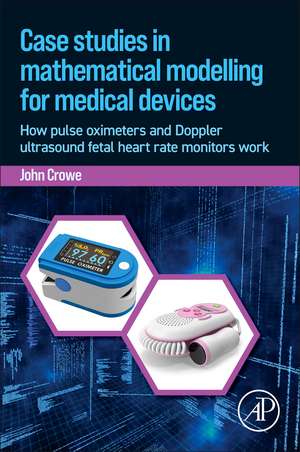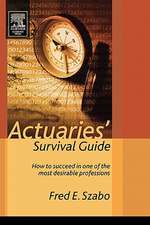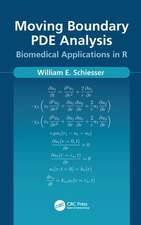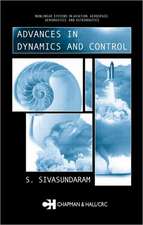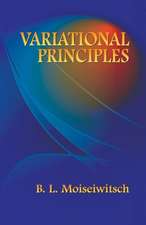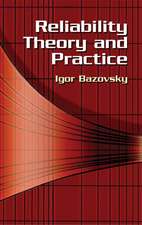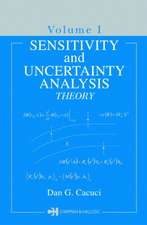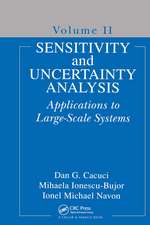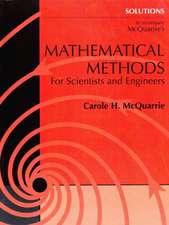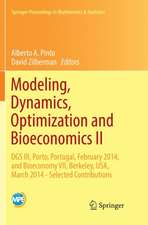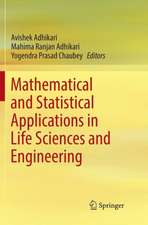Case Studies in Mathematical Modeling for Medical Devices: How Pulse Oximeters and Doppler Ultrasound Fetal Heart Rate Monitors Work
Autor John Croween Limba Engleză Paperback – 14 noi 2024
The book is for MSc and PhD students working in the area who want a quick, clear introduction to the topics, upper-division undergrads as part of biomedical engineering or applied math degree courses, biomedical engineers looking for a quick "refresher course" and clinicians interested in the operation of the instruments they use.
- Describes, from first principles, the operation of two medical diagnostic devices
- Introduces diverse and widely used mathematical topics
- Uses this knowledge to model the physical processes that underpin the devices’ operation
- Explains how clinically relevant information is obtained from the monitors’ raw outputs.
Preț: 718.08 lei
Preț vechi: 939.20 lei
-24% Nou
Puncte Express: 1077
Preț estimativ în valută:
137.40€ • 143.85$ • 113.69£
137.40€ • 143.85$ • 113.69£
Carte tipărită la comandă
Livrare economică 29 martie-12 aprilie
Preluare comenzi: 021 569.72.76
Specificații
ISBN-13: 9780323954723
ISBN-10: 0323954723
Pagini: 436
Dimensiuni: 152 x 229 mm
Greutate: 0.58 kg
Editura: ELSEVIER SCIENCE
ISBN-10: 0323954723
Pagini: 436
Dimensiuni: 152 x 229 mm
Greutate: 0.58 kg
Editura: ELSEVIER SCIENCE
Public țintă
MsC and PhD students working in the area who want a quick, clear introduction to the topics; upper-division undergrads as part of applied mathematics or biomedical engineering degree course. Biomedical engineers looking for a quick "refresher course".Cuprins
Preface ix
Acknowledgments xi
Introduction to the book xiii
PART 1 Maths for oximetry
List of symbols and abbreviations 3
1. Introduction 7
2. Discrete probability distributions 9
3. Continuous probability distributions 17
4. Summary statistics, moments, and cumulants 29
5. Commonly encountered distributions 43
6. Shifting and scaling distributions 61
7. Random samples fromdistributions 67
PART 2 Oximeters
8. Introduction: oximetry 79
9. Absorption coefficients 89
10. Lambert–Beer law 97
11. Oximetry on non-scattering samples 105
12. Scattering and the Lambert–Beer law 113
13. Attenuation versus absorption—a theoretical derivation 123
14. Pulse oximetry 135
15. Pulse oximetry on a population 147
16. TheMasimo Corporation’s oximeters 153
17. Modeling light propagation 163
18. The oximeter zoo 177
PART 3 Appendices for oximeters
19. Variance via raw moments 197
20. Taylor series 199
21. Binomial coefficients and series 201
22. Calculus 205
23. Derivatives of attenuation versus absorbance 215
24. Modeling the PPG 217
25. Fluorescence lifetimemeasurements 219
26. Logarithms 223
PART 4 Maths for DUS-FHR
List of symbols and abbreviations 229
27. Introduction 231
28. Waves 237
29. Sinusoids 241
30. Beats 249
31. Fourier analysis 253
32. Frequency domain filtering 263
33. Hilbert transform and the analytic signal 269
34. Convolution 279
35. Modulation 285
36. Sampling 293
37. Autocorrelation 299
PART 5 DUS-FHR
38. Fetal heart rate monitoring 307
39. Ultrasound 313
40. Doppler ultrasound 317
41. Doppler shift extraction 329
42. DUS-FHRmonitoring 355
43. Bandpass sampling 371
44. Pulsed operation 387
PART 6 Appendices for DUS-FHR
45. Compound angle identities 395
46. Complex numbers 397
47. Modeling with Matlab® 399
Bibliography 409
Index 413
Acknowledgments xi
Introduction to the book xiii
PART 1 Maths for oximetry
List of symbols and abbreviations 3
1. Introduction 7
2. Discrete probability distributions 9
3. Continuous probability distributions 17
4. Summary statistics, moments, and cumulants 29
5. Commonly encountered distributions 43
6. Shifting and scaling distributions 61
7. Random samples fromdistributions 67
PART 2 Oximeters
8. Introduction: oximetry 79
9. Absorption coefficients 89
10. Lambert–Beer law 97
11. Oximetry on non-scattering samples 105
12. Scattering and the Lambert–Beer law 113
13. Attenuation versus absorption—a theoretical derivation 123
14. Pulse oximetry 135
15. Pulse oximetry on a population 147
16. TheMasimo Corporation’s oximeters 153
17. Modeling light propagation 163
18. The oximeter zoo 177
PART 3 Appendices for oximeters
19. Variance via raw moments 197
20. Taylor series 199
21. Binomial coefficients and series 201
22. Calculus 205
23. Derivatives of attenuation versus absorbance 215
24. Modeling the PPG 217
25. Fluorescence lifetimemeasurements 219
26. Logarithms 223
PART 4 Maths for DUS-FHR
List of symbols and abbreviations 229
27. Introduction 231
28. Waves 237
29. Sinusoids 241
30. Beats 249
31. Fourier analysis 253
32. Frequency domain filtering 263
33. Hilbert transform and the analytic signal 269
34. Convolution 279
35. Modulation 285
36. Sampling 293
37. Autocorrelation 299
PART 5 DUS-FHR
38. Fetal heart rate monitoring 307
39. Ultrasound 313
40. Doppler ultrasound 317
41. Doppler shift extraction 329
42. DUS-FHRmonitoring 355
43. Bandpass sampling 371
44. Pulsed operation 387
PART 6 Appendices for DUS-FHR
45. Compound angle identities 395
46. Complex numbers 397
47. Modeling with Matlab® 399
Bibliography 409
Index 413
